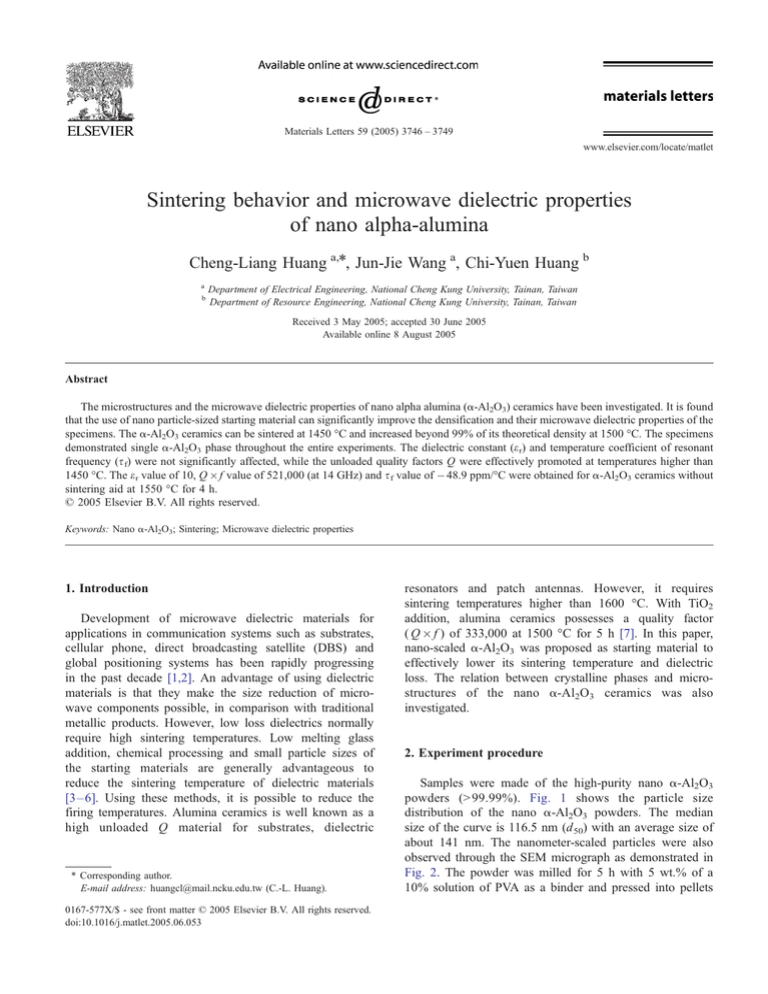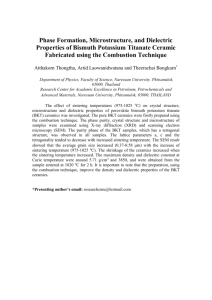
Materials Letters 59 (2005) 3746 – 3749
www.elsevier.com/locate/matlet
Sintering behavior and microwave dielectric properties
of nano alpha-alumina
Cheng-Liang Huang a,*, Jun-Jie Wang a, Chi-Yuen Huang b
a
b
Department of Electrical Engineering, National Cheng Kung University, Tainan, Taiwan
Department of Resource Engineering, National Cheng Kung University, Tainan, Taiwan
Received 3 May 2005; accepted 30 June 2005
Available online 8 August 2005
Abstract
The microstructures and the microwave dielectric properties of nano alpha alumina (a-Al2O3) ceramics have been investigated. It is found
that the use of nano particle-sized starting material can significantly improve the densification and their microwave dielectric properties of the
specimens. The a-Al2O3 ceramics can be sintered at 1450 -C and increased beyond 99% of its theoretical density at 1500 -C. The specimens
demonstrated single a-Al2O3 phase throughout the entire experiments. The dielectric constant (e r) and temperature coefficient of resonant
frequency (s f) were not significantly affected, while the unloaded quality factors Q were effectively promoted at temperatures higher than
1450 -C. The e r value of 10, Q f value of 521,000 (at 14 GHz) and s f value of 48.9 ppm/-C were obtained for a-Al2O3 ceramics without
sintering aid at 1550 -C for 4 h.
D 2005 Elsevier B.V. All rights reserved.
Keywords: Nano a-Al2O3; Sintering; Microwave dielectric properties
1. Introduction
Development of microwave dielectric materials for
applications in communication systems such as substrates,
cellular phone, direct broadcasting satellite (DBS) and
global positioning systems has been rapidly progressing
in the past decade [1,2]. An advantage of using dielectric
materials is that they make the size reduction of microwave components possible, in comparison with traditional
metallic products. However, low loss dielectrics normally
require high sintering temperatures. Low melting glass
addition, chemical processing and small particle sizes of
the starting materials are generally advantageous to
reduce the sintering temperature of dielectric materials
[3 –6]. Using these methods, it is possible to reduce the
firing temperatures. Alumina ceramics is well known as a
high unloaded Q material for substrates, dielectric
* Corresponding author.
E-mail address: huangcl@mail.ncku.edu.tw (C.-L. Huang).
0167-577X/$ - see front matter D 2005 Elsevier B.V. All rights reserved.
doi:10.1016/j.matlet.2005.06.053
resonators and patch antennas. However, it requires
sintering temperatures higher than 1600 -C. With TiO2
addition, alumina ceramics possesses a quality factor
( Q f ) of 333,000 at 1500 -C for 5 h [7]. In this paper,
nano-scaled a-Al2O3 was proposed as starting material to
effectively lower its sintering temperature and dielectric
loss. The relation between crystalline phases and microstructures of the nano a-Al2O3 ceramics was also
investigated.
2. Experiment procedure
Samples were made of the high-purity nano a-Al2O3
powders (> 99.99%). Fig. 1 shows the particle size
distribution of the nano a-Al2O3 powders. The median
size of the curve is 116.5 nm (d 50) with an average size of
about 141 nm. The nanometer-scaled particles were also
observed through the SEM micrograph as demonstrated in
Fig. 2. The powder was milled for 5 h with 5 wt.% of a
10% solution of PVA as a binder and pressed into pellets
C.-L. Huang et al. / Materials Letters 59 (2005) 3746 – 3749
3747
5
dL/L (%)
0
-5
-10
-15
-20
0
200
400
600
800 1000 1200 1400 1600
Temperature (ºC)
Fig. 1. The particle size distribution of the nano a-Al2O3 powders.
Fig. 3. The sintering shrinkage curve of the nano a-Al2O3 ceramics.
with 11 mm in diameter and 5 mm in thickness. The
relative density of the green sample of nano a-Al2O3
ceramics reached 53% at a pressing pressure of 400 MPa.
These pellets were then sintered at temperatures from 1350
to 1550 -C for 4 h in air.
The crystalline phases of the sintered ceramics were
identified by XRD patterns (XRD, D5000 Diffractometer,
Seimens, Germany). The microstructure observations of assintered surface were performed by means of scanning
electron microscopy (SEM). The bulk densities of the
sintered pellets were measured by the Archimedes method.
The dielectric constant (e r) and the quality factor values
( Q) at microwave frequencies were measured using the
Hakki-Coleman dielectric resonator method as modified
and improved by Courtney [8,9]. A system combining a
HP8757D network analyzer and a HP8350B sweep
oscillator was employed in the measurement. For temperature coefficient of resonant frequency (s f), the technique
is the same as that of quality factor measurement. The
temperature coefficient of resonant frequency (s f) at
microwave frequencies was measured in the temperature
range from 25 -C to 80 -C and is defined by:
sf ¼
Df0
ð ppm=-CÞ
f0 DT
where Df 0 is the shift in the center frequency introduced
by temperature change DT.
3. Results and discussion
The sintering shrinkage curve of the nano a-Al2O3 ceramics is
presented in Fig. 3. It indicated a starting temperature of 1200 -C
which is lower than normally seen in the pure a-Al2O3 ceramics.
Fig. 4 shows the X-ray diffraction patterns of nano a-Al2O3
ceramics at different sintering temperatures. It is understood that
the crystal system of the a-Al2O3 ceramics is hexagonal (JCPDS
#82-1468). Similar X-ray diffraction patterns were detected for the
specimens at different sintering temperatures. No second phase was
observed throughout the entire experiments.
20
Fig. 2. SEM micrographs of nanometer-scaled particles of the a-Al2O3
powders.
ð1Þ
30
40
50
60
Fig. 4. XRD patterns of a-Al2O3 ceramics sintered at (a) 1350, (b) 1400, (c)
1450, (d) 1500 and (e) 1550 -C for 4 h.
3748
C.-L. Huang et al. / Materials Letters 59 (2005) 3746 – 3749
Fig. 5. SEM micrographs of a-Al2O3 ceramics sintered at (a) 1350, (b) 1400, (c) 1450, (d) 1500 and (e) 1550 -C for 4 h.
The SEM micrographs of the a-Al2O3 ceramics at different
sintering temperatures are illustrated in Fig. 5. The as-sintered
surfaces were porous and the samples exhibited small grain size
when sintered at 1350 -C. With the increase in sintering temperature, the number of pores decreased and the rate of grain growth
apparently increased. Moreover, significant grain growth was
11
Dielectric constant
Relative density (%)
100
95
90
85
1300
1350
1400
1450
1500
1550
1600
o
Sintering temperature ( C)
Fig. 6. Relative densities of a-Al2O3 ceramics sintered at different
temperatures.
10
9
8
1300
1350
1400
1450
1500
1550
1600
o
Sintering temperature ( C)
Fig. 7. Dielectric constants of a-Al2O3 ceramics sintered at different
temperatures.
C.-L. Huang et al. / Materials Letters 59 (2005) 3746 – 3749
60
Q×f (×104)
50
40
30
20
10
0
1300
1350
1400
1450
1500
1550
1600
Sintering temperature (oC)
Temperature Coefficient of
Resonant Frequency (ppm /oC)
Fig. 8. Q f values of a-Al2O3 ceramics sintered at different temperatures.
increased with increasing sintering temperature, which was
consistent with the variation of density. It seems density plays an
important role in controlling the Q f value of the a-Al2O3
ceramics. An excellent Q f value of 521,000 (at 14.2 GHz) was
obtained for specimen sintered at 1550 -C for 4 h.
Fig. 9 shows the temperature coefficients of resonant frequency
of the a-Al2O3 ceramics at different sintering temperatures. In
general, the temperature coefficient of resonant frequency (s f) is
related to the composition and the phase that exists in the ceramics.
Since there is no second phase detected, significant change in the s f
value of the specimen was not observed. It slightly varied from
46 to 48 ppm/-C as sintering temperature increased from 1350
-C to 1550 -C.
4. Conclusion
-40
-45
-50
-55
1300
3749
1350
1400
1450
1500
1550
1600
Sintering Temperature (oC)
The microstructures and the microwave dielectric properties of the nano a-Al2O3 ceramics were investigated.
Specimen can be sintered to a relative density higher than
90% at low temperatures and still processes excellent
microwave dielectric properties. Significant change was
not observed in the s f value. In this study, a dielectric
constant (e r) of 10, a high Q f value of 521,000 (at 14.2
GHz) and a temperature coefficient of resonant frequency
(s f) of 48.96 ppm/-C was obtained at 1550 -C for 4 h.
Fig. 9. Temperature coefficient of resonant frequency (s f) of a-Al2O3
ceramics sintered at sintering temperatures.
Acknowledgement
observed and the pores were almost eliminated at 1450 -C. These
may directly affect the microwave dielectric properties of the
ceramic samples.
The relative densities of the a-Al2O3 ceramics at different
sintering temperatures are indicated in Fig. 6. A low relative
density of 88.28% was obtained at 1350 -C due to the porous
specimen as shown in Fig. 5. However, the relative density
increased and started to saturate at 1450 -C (relative density = 97.58%) with increasing sintering temperature. The increase
in relative density with increasing sintering temperature was
attributed to the decrease in the number of pores as well as grain
growth observed in Fig. 5. It shows that the relative density of aAl2O3 ceramics increased from 88.28% at 1350 -C to 99.11% at
1550 -C.
Fig. 7 shows the plots of dielectric constant of the a-Al2O3
ceramics as a function of sintering temperature. The relationships
between e r values and sintering temperatures reveal the same trend
with those between densities and sintering temperatures since
higher density was mainly a result from lower porosity. The e r
values rapidly increased from 8.6 at 1350 -C to 9.7 at 1450 -C and
then saturated at 10 for the well-sintered ceramics.
Fig. 8 demonstrates the Q f value of a-Al2O3 ceramics as a
function of its sintering temperature. The Q f value also
This work was supported by Ministry of Economic
Affairs (92-EC-17-A-08-S1-023) through Particulate Materials Research Center of National Cheng Kung University.
References
[1] W. Werising, in: B.C.H. Steele (Ed.), Electronic Ceramics, Elsevier,
London, 1991, p. 67.
[2] G. Wolfram, H.E. Gobel, Mater. Res. Bull. 16 (1981) 1455.
[3] T. Kakada, S.F. Wang, Syoshikawa, S.T Jang, R.E. Newnham, J. Am.
Ceram. Soc. 77 (1994) 1909.
[4] T. Kakada, S.F. Wang, Syoshikawa, S.T Jang, R.E. Newnham, J. Am.
Ceram. Soc. 77 (1994) 2485.
[5] S.I. Hirno, Takashi, Hayashi, A. Hattori, J. Am. Ceram. Soc. 74 (1991)
1320.
[6] V. Tolmer, G. Desqardin, J. Am. Ceram. Soc. 80 (1997) 1981.
[7] N.M.C.N. Alford, S.J. Penn, Sintered alumina with low dielectric loss,
J. Appl. Phys. 80 (1996) 5895 – 5898.
[8] B.W. Hakki, P.D. Coleman, IEEE Trans. Microwave Theor. Tech. 8
(1960) 402.
[9] W.E. Courtney, IEEE Trans. Microwave Theor. Tech. 18 (1970) 476.


